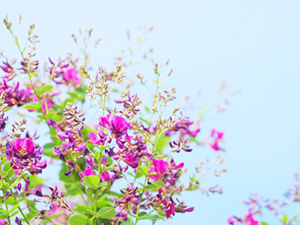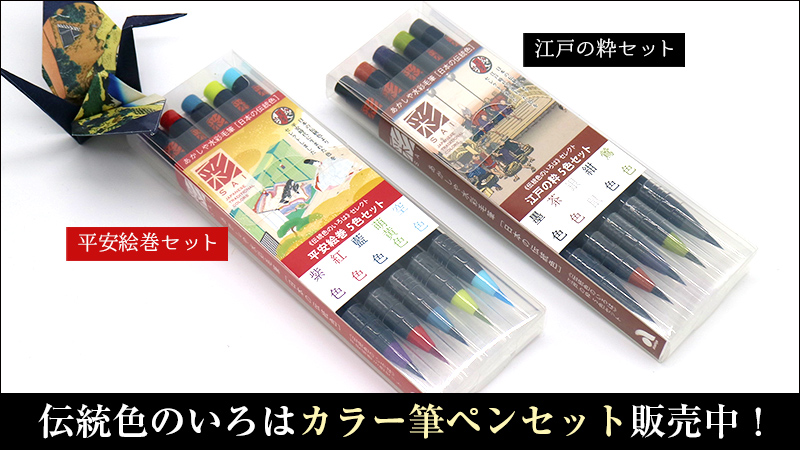| 色の名前Japan Color Name | 萩色(はぎいろ) |
|---|---|
| ローマ字Romanized | Hagi-iro |
| RGB | R:226 G:079 B:147 |
| CMYK | C:00 M:80 Y:00 K:05 |
| Web カラーHex triplet | |
| 誕辰色 | 6月25日 |
色の説明
萩色(はぎいろ)とは、秋の山野に咲く萩 の花のような紫みの明るい紅 色のことです。 古くからの色名で、もともとは重 ねの色や織り色の名前でした。
平安時代の古典「栄花物語」にも、女房装束として「萩の唐衣 」の記述がみられます。
萩は「秋の七草」に選ばれているように秋を代表する花で、可憐な紅色の花が古くから日本人に愛されました。万葉集にも萩をテーマにした歌が数多く詠まれ、“清少納言”の「枕草子」など平安文学にも数多く登場します。
萩 (ハギ)
萩はマメ科ハギ属の総称。落葉低木。秋の七草のひとつで、花期は7月から10月。
萩の文字は日本固有の字で、文字形成はその草が秋を代表することから、「秋」の字に「草かんむり」をつけたものとなった。古くは「芽子 」と書かれている。
また萩の花は、花札の7月札のモチーフとしても有名。
重 ねの色目では「表紫、裏白」で萩の花を表した配色となっています。 着用時期は六・七月。
なお、『萩』の織色が「経糸・青、緯糸・蘇芳 」であることから、「表蘇芳、裏青」の別説もあります。
ちなみに、萩がつく色名には他に『夏萩 』や『萩経青 』、『萩重 』がありますが、いずれも襲の色に由来する色名です。
萩は江戸時代の俳人“森川許六 ”も「萩はやさしき花也。」と紹介しているように、たおやかで儚い印象です。
『萩色』を使用する場合はそのイメージのように控えめに使いたいものですね。
 萩の花
萩の花
-読み:はぎいろ-
「朽葉の唐衣、薄色の裳に、紫苑、萩など、をかしうて居並みたりつるかな。」
『枕草子』。平安時代中期。清少納言。
関連する色の紹介

対い萩:家紋のいろは
[Explanation of a color]
Thr Hagiiro is a bright purple color like purple flowers blooming in the autumn mountains. It is an old color name, originally the name of the attack color and weave color. In the Heian period classic 'Eika Hana Monogatari', you can also find 'Samu no Torii' as a wife's costume.
A rose is a flower representing autumn as selected as "fall seven herbs", and a pretty crimson flower has been loved by the Japanese for a long time. Many songs are also sung on the theme of Zen in Manyoshu, and many appear in Heian literature such as "Makura-no-soushi" in "Seisho Nagon."
Hagi
Acupuncture is a generic term for legumes. Fallen leaves shrubs. It is one of the seven plants in autumn, and the flowering season is from July to October. The letter of 萩 is unique to Japan, and the letter formation is that the grass represents autumn, so the letter of "autumn" has "Kanmuri". It is written as "芽子" in old times.
In addition, a rose flower is also famous as a motif for the July tag of Hanafuda.
In Kasane's eyes, it is a color scheme representing a rose flower with "front, purple, back, white". Wearing time is June and July.
In addition, since the weave color of "Kaki" is "warp, blue, weft, Suou", there is another theory of "front, Suou, back, blue".
By the way, there are "Natsuhagi", "Hagitateao", and "Hgigasane" as the color names that get wrinkled, but they are all color names derived from the color of the attack.
As is the case of the Edo period haiku poet “Morikawa Kyoriku” as “A kindly flower.” It is a relaxed and ugly impression. If you use "萩", you want to use it sparingly like the image.
-read: Hagi-iro-
参考書籍
- 長崎盛輝『新版 日本の伝統色 その色名と色調』青幻舎 ISBN-10:4861520711
- 吉岡幸雄『日本の色辞典』紫紅社 ISBN-10:4879405493
- 内田 広由紀『定本 和の色事典』視覚デザイン研究所 ISBN-10:4881082035
注意事項
表示されている色(RGB値)は色の名前に対するおおよそものです。色名によっては広範囲の色を指す場合や文献・書籍等によっては解釈が異なる場合もありますのでご了承ください。 ご利用の環境によっては、色が適切に表示されていない場合があります。
印刷などに伝統色を利用したい場合は、DICグラフィックス株式会社から発売されている日本の伝統色シリーズがオススメです。
Pinterestでシェアする際にご利用ください。
サイト運営者からのお願い
このサイトが気に入った、役に立ったと思われた方は、Amazon・楽天で買い物をする際はぜひ下記のバナーをタップしてからお買い物をお願いいたします。
こちらからお買い物をしていただきますと、価格の1%相当のポイントがサイトに入ります。もちろんその分、高くなるようなことはありません。
いただいたポイントは今後のサイト運営のための書籍代や運営費、モチベーションにつながりますので、ご協力いただけますと嬉しいです。

 DIC 日本の伝統色 第9版
DIC 日本の伝統色 第9版



